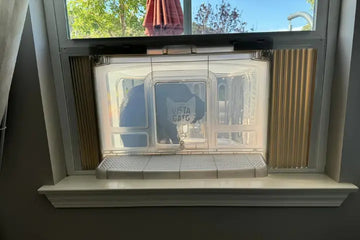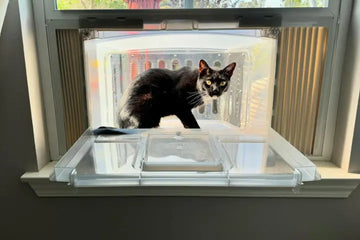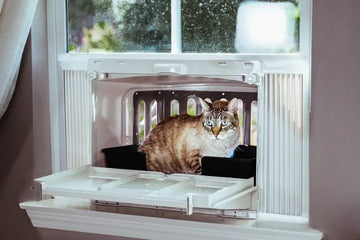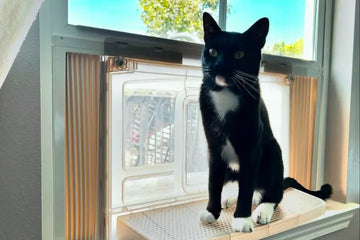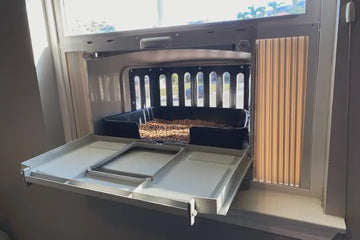Choosing the right litter box for cats is a crucial decision that pet owners must make to ensure their furry friends' happiness and health. A litter box isn't just a simple container; it's a vital part of your cat's daily life, significantly impacting their comfort and well-being. A suitable litter box can help maintain cleanliness in your home, minimize odors, and provide your cat with a private space to do their business. Conversely, the wrong choice can lead to unpleasant smells, messes, and even behavioral issues, such as avoiding the litter box altogether. Therefore, it's essential to consider various factors, including size, type, and features, when selecting a litter box, to cater to your cat's specific needs and preferences.

Exploring the Cat Litter Box Types
Traditional vs. Modern
When deciding to choose a cat litter box, pet owners are often faced with the choice between traditional and modern options. Traditional litter boxes are typically simple, rectangular trays that offer straightforward functionality without additional features. These boxes are usually more affordable and can be a good fit for cats who prefer simplicity. On the other hand, modern litter boxes come with various enhancements designed to improve convenience and hygiene. The choice between traditional and modern types should be based on your cat's behavior and your lifestyle.
The Rise of Self-Cleaning Litter Boxes
The self-cleaning litter box for cats represents a significant advancement in pet care technology, offering convenience and improved hygiene. These innovative boxes are designed to automatically remove waste without the need for daily scooping, reducing the unpleasant task of litter box maintenance. Self-cleaning boxes typically use a mechanism to sift through the litter after each use, separating waste into a concealed compartment. This feature not only helps in keeping the litter box clean but also assists in controlling odors effectively. While self-cleaning litter boxes are generally more expensive than traditional options, they can be a worthy investment for busy pet owners looking for ways to simplify their pet care routine.
Natural Ventilation
A window litter box for cats offers a unique solution by integrating the litter box with a window, providing natural ventilation to help control odors. The concept involves a litter box that fits securely within a window frame, allowing odors to escape directly outside rather than permeating the indoor environment. In addition to odor control, window boxes can also provide a stimulating view for your cat, making their litter box experience more enjoyable.
Solutions for Households with Multiple Cats
For homes with more than one feline friend, litter boxes for multiple cats are a must to prevent territorial issues and ensure hygiene. These boxes are typically larger to accommodate multiple users and provide ample space for each cat to feel comfortable. Some multi-cat litter boxes also feature multiple entrances or are designed in a way that allows more than one cat to use the box at the same time while maintaining privacy. It's important to have enough litter boxes in the home – usually, the rule of thumb is one box per cat plus one extra – to avoid competition and ensure each cat has access when needed.
Key Considerations for Selecting a Litter Box
Size and Comfort
The right size is imperative when selecting a comfortable litter box for cats. A box that's too small can make your cat feel cramped and discourage its use, while one that's overly large may intimidate smaller breeds or kittens. Ideally, the litter box should be spacious enough for your cat to turn around, dig, and squat without touching the sides or spilling litter outside. For full-grown cats, a box that's at least 1.5 times the length of your cat from the nose to the base of the tail is recommended. This ensures they have enough room to move comfortably.
Material and Design
Deciding the material and design becomes even more crucial when selecting a window-mounted litter box, as it affects not only the functionality and longevity of the litter box but also the safety and comfort of your cat, and the overall impact on the environment and your home's aesthetics. Here are essential considerations:
- Durability: The longevity of the material is a key consideration. You’ll want to choose a material that can withstand the daily use and abuse a litter box is subjected to. This includes being resistant to scratching, moisture, and the wear and tear from cleaning. A durable material ensures that the litter box will serve your cat well over time, without the need for frequent replacements.
- Safety: The safety of the material used in the litter box is paramount. This includes ensuring that there are no harmful chemicals that could be ingested or come into contact with your cat’s skin. Additionally, the design should be free of sharp edges or small, detachable parts that could pose a risk of injury or choking. A safe design prioritizes your cat’s well-being in every aspect.
- Eco-Friendliness: With growing environmental concerns, the ecological impact of the materials used is an important consideration. Opting for biodegradable or recyclable materials can significantly reduce your environmental footprint. Products made from sustainable resources not only benefit the environment but often come with the added benefit of being healthier for your pet and your family.
- Aesthetics: Finally, the design of the litter box should harmonize with your home’s interior. With a wide range of materials and designs available, from sleek plastics to natural, eco-friendly options, you can choose a litter box that not only meets functional requirements but also complements your home décor. Aesthetic considerations ensure that the litter box is not just a necessity, but a thoughtful addition to your home.
This comprehensive approach to material and design choice not only enhances the quality of life for your cat but also aligns with your values and home environment, creating a cohesive and comfortable space for everyone.
Easy Cleaning Features
Selecting easy-to-clean cat litter boxes is paramount for maintaining a hygienic environment for both your cat and your home. Litter boxes with non-stick surfaces have become increasingly popular, as they significantly reduce the amount of waste that adheres to the sides and bottom of the box. This feature greatly simplifies the cleaning process, making daily maintenance less of a chore and more efficient. Regardless of the type of litter box chosen, combining such features with high-quality clumping litter can further enhance cleanliness and odor control. Additionally, placing a mat around the litter box can catch any stray litter from your cat's paws, reducing tracking and keeping the surrounding area clean.

Odor Control Mechanisms
An odor control cat litter box is crucial for keeping your living space smelling fresh. Many modern litter boxes are designed with built-in features to minimize odors, such as carbon filters that trap and neutralize smells or covers that help contain them. However, it's important to balance odor control with your cat's preference for open versus covered boxes, as some cats may reject enclosed spaces.
Doubling as a Mini Catio
It can serve a dual purpose, acting not only as a litter box but also as a mini catio, offering your feline friend a safe way to enjoy the outdoors. This innovative concept allows cats to experience the sights, sounds and smells of the outside world, which can be mentally stimulating and enriching for them. Having access to a window box for cats can reduce boredom and anxiety, promoting a happier and more contented pet. The sensory stimulation from the outdoor environment can engage your cat's instincts, keeping them both physically active and mentally sharp. It's a wonderful way to enhance your cat's quality of life while keeping them safe and secure indoors.
The Placement of Your Cat’s Litter Box
Finding the Perfect Spot
A quiet, low-traffic area of your home can make your cat feel secure and encourage consistent use of the box. However, it's equally important to place the litter box in a location that your cat can easily reach at any time, without having to navigate through obstacles or busy areas. For households with multiple floors, consider placing a litter box on each level to accommodate your cat's needs wherever they choose to spend their time.
Adjusting Placement
Pay attention to your cat's behavior for clues about their preferred litter box location. Some cats may seek out quieter, more secluded spots, while others might prefer areas with a view. If your cat avoids their litter box, consider moving it to a new location to see if it makes a difference. Additionally, environmental changes in your home, such as new furniture arrangements or the introduction of new pets, can affect your cat’s litter box usage.
Accommodating Your Cat’s Unique Preferences
Observing Their Behavior
Cats communicate their preferences and discomforts through subtle behavioral cues, making it important for pet owners to be attentive to these signals. By understanding what to look for, you can ensure that your cat's litter box meets their needs, promoting a healthy and stress-free environment for your furry friend. Here are key behaviors to monitor:
- Box Usage: Regular and distress-free use of the litter box is a clear sign that your cat is comfortable with the current setup. A cat that consistently uses its litter box without showing signs of stress or avoidance is likely content with the box's location, size, and the type of litter used. This consistent use is indicative of a well-adjusted cat that feels secure in its environment.
- Elimination Outside the Box: Finding waste outside the litter box is a strong indicator that something isn't right. This behavior can signal various issues, ranging from the cleanliness of the box, and its location within your home, to the type of litter being used. It's a call for attention to reassess the litter box setup and make necessary adjustments to cater to your cat's preferences or resolve any underlying issues.
- Digging and Covering Habits: If your cat is excessively digging in the litter or seems to struggle with covering their waste, it might indicate dissatisfaction with the litter itself. The problem could be related to the type of litter (e.g., texture or scent) or the depth at which the litter is provided. Cats have instincts to bury their waste, and any deviation from this behavior warrants a closer examination of the litter's properties.
- Entering and Exiting: Pay attention to how your cat approaches and leaves the litter box. Hesitation or rapid exit can suggest discomfort with the litter box, possibly due to its size, design, or location.
- Vocalization: Any sounds or vocalizations made while in the litter box should not be ignored. Cats typically use the litter box silently, so any meowing, hissing, or other sounds can indicate distress or discomfort. This could be due to physical pain (suggesting a health issue) or dissatisfaction with the litter box setup.
By paying close attention to these behaviors, cat owners can gain insights. Ensuring your cat has a comfortable and appealing litter box environment can prevent behavioral issues and promote a harmonious living situation for both you and your cat.
Adjusting for Age, Health, and Mobility Issues
Young kittens, for example, require litter boxes with lower sides for easy access, while older cats or those with arthritis benefit from boxes with high sides for support but low entry points to ease access. Health conditions such as diabetes may increase the frequency of urination, necessitating a larger box or more frequent cleaning. Adapting the litter box to accommodate these changes is essential for your cat's comfort and hygiene. Regular veterinary check-ups can also provide wisdom into any adjustments needed to cater to your cat's evolving needs.

When to Replace
Generally, it's advisable to replace your cat's litter box once a year, although this can vary depending on the material of the box and how well it's holding up. Plastic boxes, for example, tend to absorb and retain odors more than other materials. If you notice persistent smells despite regular cleaning, or if the box shows significant wear and tear, it's time for a replacement.
The ongoing comfort and cleanliness provided by the right litter box setup are crucial for a lasting and positive relationship between you and your cat. Staying informed about new litter box technologies and being open to changing your approach as your cat's needs evolve can make a significant difference in their quality of life. Continuously striving for the best litter box solution emphasizes your commitment to your cat's health and happiness, ensuring that they feel secure, respected, and loved in your shared home.



